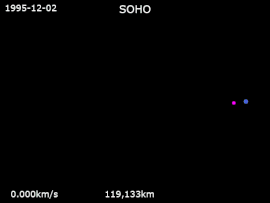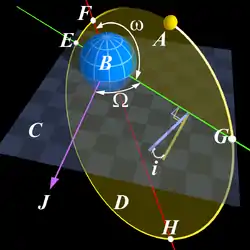Halo orbit
A halo orbit is a periodic, three-dimensional orbit near one of the L1, L2 or L3 Lagrange points in the three-body problem of orbital mechanics. Although a Lagrange point is just a point in empty space, its peculiar characteristic is that it can be orbited by a Lissajous orbit or by a halo orbit. These can be thought of as resulting from an interaction between the gravitational pull of the two planetary bodies and the Coriolis and centrifugal force on a spacecraft. Halo orbits exist in any three-body system, e.g., a Sun–Earth–orbiting satellite system or an Earth–Moon–orbiting satellite system. Continuous "families" of both northern and southern halo orbits exist at each Lagrange point. Because halo orbits tend to be unstable, station-keeping using thrusters may be required to keep a satellite on the orbit.



| Part of a series on |
| Astrodynamics |
|---|
 |
Most satellites in halo orbit serve scientific purposes, for example space telescopes.
Definition and history
Robert W. Farquhar first used the name "halo" in 1966 for orbits around L2 which were made periodic using thrusters.[1] Farquhar advocated using spacecraft in such an orbit beyond the Moon (Earth–Moon L2) as a communications relay station for an Apollo mission to the far side of the Moon. A spacecraft in such an orbit would be in continuous view of both the Earth and the far side of the Moon, whereas a Lissajous orbit would sometimes make the spacecraft go behind the Moon. In the end, no relay satellite was launched for Apollo, since all landings were on the near side of the Moon.[2]
In 1973 Farquhar and Ahmed Kamel found that when the in-plane amplitude of a Lissajous orbit was large enough there would be a corresponding out-of-plane amplitude that would have the same period, so the orbit ceased to be a Lissajous orbit and became approximately an ellipse. They used analytical expressions to represent these halo orbits; in 1984, Kathleen Howell showed that more precise trajectories could be computed numerically. Additionally, she found that for most values of the ratio between the masses of the two bodies (such as the Earth and the Moon) there was a range of stable orbits.[3]
The first mission to use a halo orbit was ISEE-3, a joint ESA and NASA spacecraft launched in 1978. It traveled to the Sun–Earth L1 point and remained there for several years. The next mission to use a halo orbit was Solar and Heliospheric Observatory (SOHO), also a joint ESA/NASA mission to study the Sun, which arrived at Sun–Earth L1 in 1996. It used an orbit similar to ISEE-3.[4] Although several other missions since then have traveled to Lagrange points, they (eg. Gaia astrometric space observatory) typically have used the related non-periodic variations called Lissajous orbits rather than an actual halo orbit.
In May 2018, Farquhar's original idea was finally realized when China placed the first communications relay satellite, Queqiao, into a halo orbit around the Earth-Moon L2 point.[5] On 3 January 2019, the Chang'e 4 spacecraft landed in the Von Kármán crater on the far side of the Moon, using the Queqiao relay satellite to communicate with the Earth.[6][7]
The James Webb Space Telescope entered a halo orbit around the Sun-Earth L2 point on 24 January 2022.[8] Euclid entered a similar orbit around this point in August 2023.
India's space agency ISRO plans to launch Aditya-L1 to study the sun from a halo orbit around L1.[9]
See also
- Interplanetary Transport Network
- Interplanetary spaceflight
- Lissajous orbit, another Lagrangian-point orbit which generalizes halo orbits.
- Near-rectilinear halo orbit
- Category:Spacecraft using halo orbits
- Libration point orbit
References
- Robert Farquhar (1966). "Station-Keeping in the Vicinity of Collinear Libration Points with an Application to a Lunar Communications Problem". AAS Science and Technology Series: Space Flight Mechanics Specialist Symposium. 11: 519–535., see Farquhar, R.W.: "The Control and Use of Libration-Point Satellites", Ph.D. Dissertation, Dept. of Aeronautics and Astronautics, Stanford University, Stanford, California, 1968, pp. 103, 107–108.
- Schmid, P. E. (1 June 1968). "Lunar far-side communication satellites". NASA, Goddard Space Flight Center. Retrieved 16 July 2008.
- Howell, Kathleen C. (1984). "Three-Dimensional Periodic Halo Orbits". Celestial Mechanics. 32 (1): 53–71. Bibcode:1984CeMec..32...53H. doi:10.1007/BF01358403. S2CID 189831091.
- Dunham, D. W.; Farquhar, R. W. (2003). "Libration Point Missions, 1978–2002". Libration Point Orbits and Applications. pp. 45–73. doi:10.1142/9789812704849_0003. ISBN 978-981-238-363-1.
- Xu, Luyuan (15 June 2018). "How China's lunar relay satellite arrived in its final orbit". The Planetary Society.
This is the first-ever lunar relay satellite at this location.
- Jones, Andrew (5 December 2018). "China to launch Chang'e-4 lunar far side landing mission on December 7". gbtimes.com. Archived from the original on 15 April 2019.
- Jones, Andrew (3 January 2019). "Chang'e-4 returns first images from lunar farside following historic landing". SpaceNews.com. Retrieved 8 January 2019.
- Roulette, Joey (24 January 2022). "After Million-Mile Journey, James Webb Telescope Reaches Destination – The telescope's safe arrival is a relief to scientists who plan to spend the next 10 or more years using it to study ancient galaxies". The New York Times. Archived from the original on 24 January 2022. Retrieved 24 January 2022.
- "After Chandrayaan-3, ISRO getting ready for Sun mission ADITYA-L1. Key things to know". The Economic Times. 24 July 2023. Retrieved 24 July 2023.
External links
- SOHO – The Trip to the L1 Halo Orbit
- Low Energy Interplanetary Transfers Using Halo Orbit Hopping Method with STK/Astrogator
- Gaia's Lissajous Type Orbit – a Lissajous-type orbit, i.e., a near-circular ellipse or "halo"